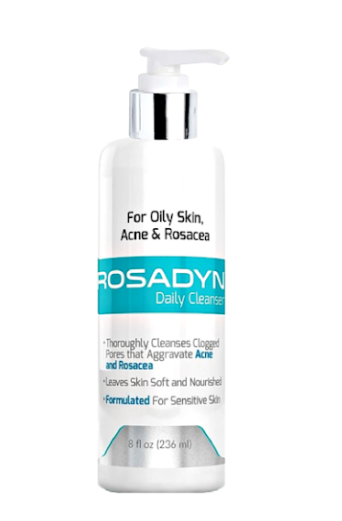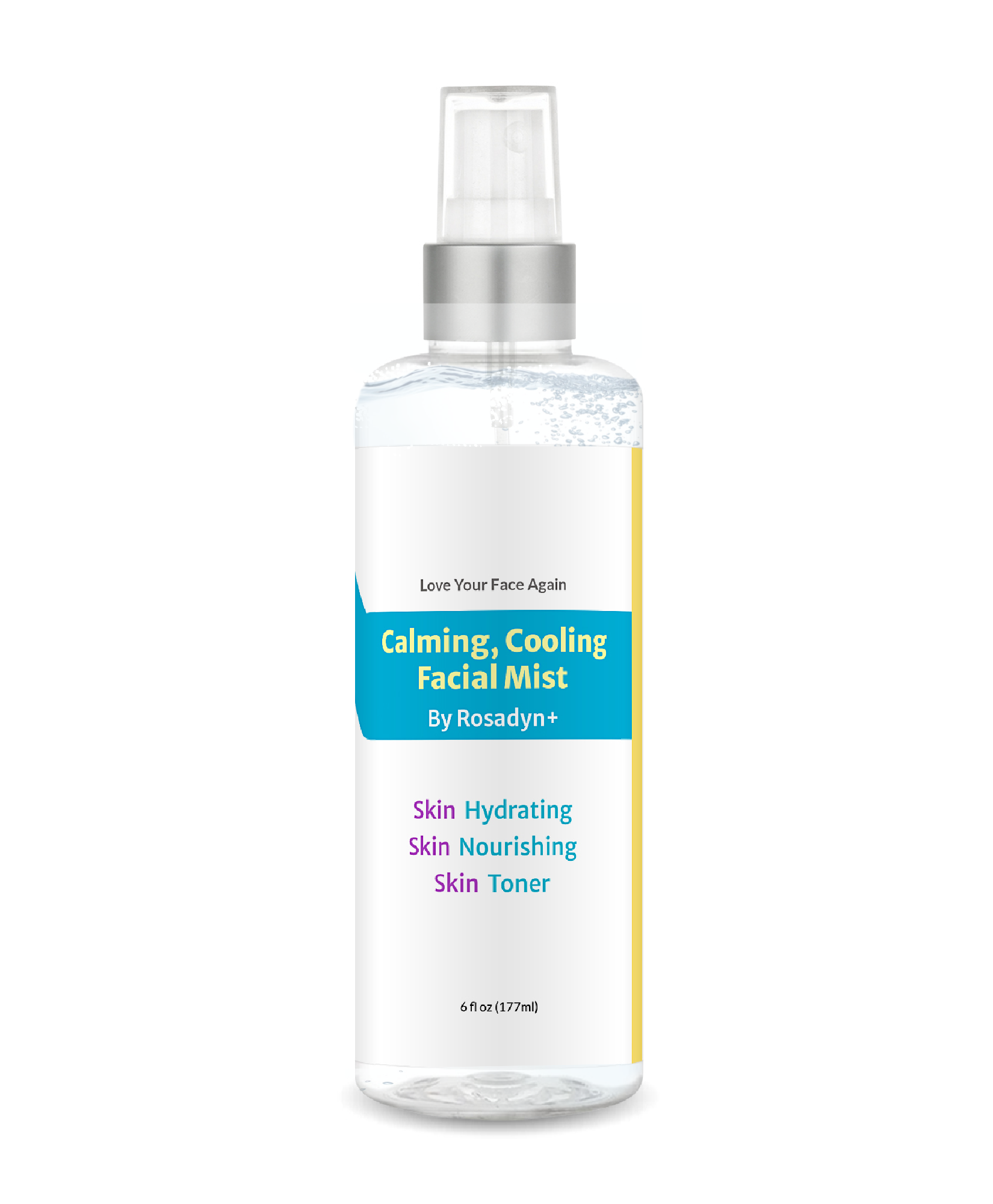About Rosacea
What is Rosacea?
Rosacea is a chronic skin disorder that affects the facial skin and eyes. It usually begins quite innocently as a mild flush across the nose, cheeks, chin, and forehead. During the early stages, this flush comes and goes, seeming to have a mind of its own. As the disorder progresses, facial redness becomes more intense, taking on the appearance of mild sunburn or windburn. In areas of facial redness, tiny broken blood vessels and red bumps may also become visible.
In the moderate to severe stages, facial inflammation usually intensifies, resulting in permanent redness, swelling, and burning sensations. In the most advanced cases, rosacea can cause facial disfigurement and disabling burning sensations.
According to the latest epidemiological studies, rosacea affects over 45 million people worldwide. In the United States alone an estimated 14 million Americans are afflicted with this disease.
Diagnosing: Rosacea Phenotype
Diagnosis of rosacea should be considered when:
- A centralised redness of the face that varies with intensity, but persists and/or
- Swelling of the sebaceous glands as seen as phymatous* changes.
*Phymatous rosacea is characterised by thickened skin with enlarged pores and irregular surface nodularities. These changes are most commonly found on the nose (rhinophyma), but can occur on the ears, chin and forehead.Secondary Signs:burning or stinging, swelling and dry appearance, may also develop but are not diagnostic.
Major Features: Facial Redness, Flushing, Breakouts, Broken Veins, Eyes
- Transient centrofacial erythema – central face area frequent flushing; persistent erythema (ie, lasting for at least 3 months); .
- Inflammatory papules/pustules
- Telangiectasia – condition in which widened tiny blood vessels cause threadlike red lines or patterns on the skin. (spider vein like that can form in clusters)
- Ocular manifestations – eye involvement, eye redness, burning and itching eyes and swollen eyelids
Minor Features: Facial Burning, Fluid Retention, Dry Skin
- Burning/stinging sensation
- Oedema *build-up of fluid causes affected tissue to become swollen
- Dry sensation/appearance
- Other
Rosacea: The Severity Scale of Rosacea
Rosacea normally advances in the same generalized fashion: In the beginning rosacea symptoms usually starts out quite innocently as a mild flush across the nose, cheeks, chin, and forehead. As rosacea progresses, the hypothalamus, an area of the brain that regulates many important bodily functions, becomes overactive. A ‘sensitized’ hypothalamus triggers nerve activity and hormone release, which in turn, accelerates all rosacea symptoms. These changes usually occur in stages:
Stage 1: Pre-Rosacea
Symptoms
Frequent bouts of facial flushing. At this stage, facial redness from the flush is very brief and immediately disappears after the trigger is over. For example, a short term flush brought on by a warm environment, exercise, facial cleansing, overheating, or embarrassing situation, can all be categorized as pre-rosacea flushes. rosacea skin closeup
General Discussion
Although this stage is usually quite innocent in nature, pre-rosacea flushing is the first sign of rosacea. In the pre-rosacea stage, most sufferers experience a basic functional change in the reactivity of facial blood vessels – i.e., rosacea blood vessels dilate to more stimuli, open wider, and stay open for longer periods of time than do normal facial blood vessels.
✔ Facial flushing comes and goes
✔ Sensitivity to topical products
✔ Burning or stinging sensations
✔Facial redness triggered by internal and external insults
Stage 2: Mild Rosacea
Symptoms
Abnormally long periods of facial flushing The mild stage of rosacea begins when the facial redness induced by flushing persists for an abnormal length of time (usually a half-an-hour or more after the trigger).
During this stage, many rosacea sufferers also report that their facial skin has a healthy-looking glow to it. mild rosacea
General Discussion
In mild rosacea, facial blood vessels become even more reactive – resulting in greater blood flow through the superficial layers of the facial skin. Facial blood vessels also remain open for exaggerated periods of time, resulting in facial redness that persists for an extended period of time after the trigger is over. In mild rosacea, there may also be minor structural damage to facial blood vessels, but this is not an important factor at this stage.
✔ Blood vessels become sensitive to external and internal stimuli
✔ Blood vessels dilate even wider and can stay dilated for 30 to 90 minutes at a time
✔ Mild skin inflammation
✔ Skin inflammation begins to damage cell membranes
Stage 3: Moderate Rosacea
Symptoms
Persistent redness that lasts for days or weeks. The moderate stage of rosacea begins when the facial redness persists for days or weeks – often becoming semi-permanent in the central areas of the face such as the nose and cheeks. This results in a generalized ‘sun-burnt’ or ‘wind-burnt’ look.
In facial areas where chronic flushing or redness is intense, swelling and burning sensations may also occur. A significant number of patients also report outbreaks of tiny red bumps during this stage. In most cases there are prominent areas of dilated blood vessels in facial areas where flushing is the worst. Rosacea How To Guide
General Discussion On Rosacea
As facial flushing becomes more frequent and intense, blood vessels become more dysfunctional and often incur structural damage. These vascular changes result in long-lasting facial redness, broken blood vessels, swelling, and inflammatory bumps. Facial blood vessel damage can range from mild damage that can still function normally, to severe damage denoted by permanently dilated vessels that cannot repair themselves.
The result is skin that is in a chronic inflammatory state. This in turn stimulates the growth of new vessels to handle the increased blood flow, and the fusion of pre-existing damaged vessels. Both of these changes, in turn, worsen the entire vascular disease. The damaged and dysfunctional facial blood vessels can also contribute to swelling, inflammatory papules and pustules.
✔ Facial redness becomes more intense
✔ The appearance of mild sunburn or windburn occurs
✔ Papules, pustules and swelling often develop; Centro-facial pores enlarge
✔ Swelling occurs in the cheek and nose area.
✔ In areas of facial redness, tiny broken blood vessels and red bumps may also become visible.
✔ Burning and itching sensations intensify
Stage 4: Severe Rosacea
Symptoms
Intense bouts of facial flushing, severe inflammation, swelling and burning sensations. A small portion of sufferers progress to the final stage of rosacea which is characterized by intense bouts of facial flushing, severe inflammation, swelling, facial pain, and debilitating burning sensations. On top of the inflammation can emerge crops of inflammatory papules, pustules, and nodules. At this stage, some patients may also develop rhinophyma, a bulbous enlargement of the nose.
General Discussion
After months, years, or decades of uncontrolled flushing and inflammation, permanent changes take place in the facial skin and blood vessels. Major changes include: Widespread damage to facial blood vessels, extreme hyper-reactivity of the remaining blood vessels, significant leakage from damaged blood vessel walls, and adverse changes to facial skin structure.
In severe rosacea, the uncontrolled flushing leads to structural damage,
which contributes to the inflammation, which in turn further stimulates the flushing.
This is a vicious cycle that is difficult to break because permanent damage has now been done,
new vessels have grown, and inflammatory shunt vessels have formed.
✔ Intense facial flushing, permanent redness and severe facial swelling
✔ An increase in papules, pustules and the appearance of deep inflammatory nodules.
✔ Extreme facial hyper-sensitivity and intense burning sensations
✔ Facial swelling
✔ Spread of excess facial tissue called fibroplasia may develop
Additional recommended articles about rosacea:
- Common medical terms used to describe rosacea translated into every day English
- Helpful list of topics, questions and symptoms to discuss with your doctor about your rosacea. Why Keeping A Checklist Matters With Rosacea Treatment and Management to get the most out of your appointment.

Try Rosadyn+ Nutraceutical Risk-Free for 90 Days
Rosacea is a complex disorder and no two people have exactly the same reaction to rosacea treatments. What feedback from thousands of our customers has made clear, however, is that the response time to Rosadyn+ varies with the severity of their rosacea, general health, diet and lifestyle. This said, we have customers with mild rosacea who saw a minimization of their flares, facial redness and symptoms after six weeks of Rosadyn+ while those with more severe cases needed three-to-six months to ultimately break the chronic inflammatory cycle of rosacea.
Because the time to achieve results can vary significantly, we offer a generous, unprecedented 90 day, money-back guarantee on our oral nutraceutical limited to 3 bottles (90 days) to give you ample time to allow Rosadyn to work for you. All we ask is that new customers use that full 90 day risk-free time window to fairly evaluate the rosacea-fighting power of Rosadyn+ and avoid the common mistake of abandoning treatment prematurely, particularly after just one month.
*90 day gurantee – supplement only – 3 Bottle Maximum, does not include other products, Supplements only
Love Your Face Again with Rosadyn™
Proven Effective Rosacea Skin Care Products
Gel Cleanser w/Organic Honey
Honey, Aloe and Oat - Gentle Face Wash for Oily and Acne Prone Sensitive Skin
Combine Products and Save!
Read Our Rosacea Blog - Tips, Product Reviews to Studies and More!...
The Rosacea Blog
Be sure to frequently check out our blog. We love sharing the latest news, helpful tips cool product reviews, latest research and occasionally inspirational stories from our rosacea family.
How Rosadyn Reduces Rosacea Sun and Heat Triggers
Heat, Sun and Rosacea Flares While summer is beach time for many, the sun and heat can be a trial by fire for rosacea sufferers. Sun and heat exposure are the #1 and 3 rosacea triggers according to the American Academy of Dermatology. That means summertime is a...
Rosacea and Menopause, a Rosadyn Love Story
Menopause Triggered My Rosacea I am 54 years old and have been enjoying menopausal symptoms for about 3 years now. “Enjoy” is not the verb I want to use but I will keep it dignified. One of the funnest parts of menopause are the hot flashes. I think I just...
Natural Rosacea Treatment, Dermatologists Say Yes!
Dermatologists Embrace Herbs To Decrease Rosacea Symptoms Topical extracts have long been used to treat sensitive skin, rosacea skin and many other forms of inflammatory skin disorders. Until recently, most dermatologists have focused on using prescription...
Cooling foods that help to naturally lower body temperature and reduce rosacea flushing
Summer along with weather changes can cause your rosacea to flare up. With UV Rays and heat, you have a variety of external options to address the suns rays from sun protection hats and clothing, sunscreens to Rosadyn+ natural ingredients that help with strengthening...
Best Winter Skin Care Barrier Cream for Rosacea – Product Review
Objective: The purpose of this article is to discuss why most rosacea sufferers flare during the harsh environment of the winter. We are highlighting a skin care barrier cream for Rosacea, that protects the skin from environment-induced flushing, skin inflammation...
B-Vitamins Common Cause of Skin Breakouts and Redness
The purpose of this article is to highlight the fact that B Vitamins and B Vitamin Complexes can contribute to acne rosacea, facial redness, flushing and even trigger acne in non-rosacea sufferers. B Vitamins are one of the top selling vitamins due to their many...
| Support | About us |
|---|---|
| FAQs | Text contact: 626-375-5259 |
| Rosadyn+ Guarantee | Terms and conditions |
| Customer Service | Privacy Policy |
| Contact us | Data Retention Policy |















